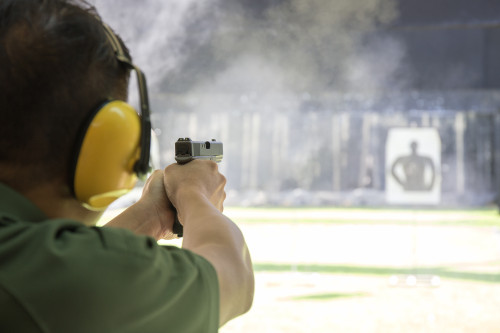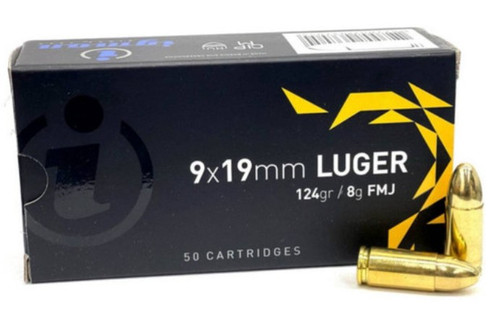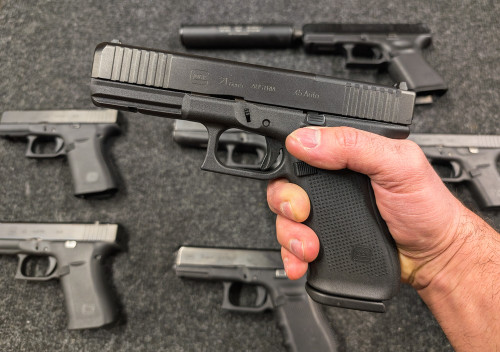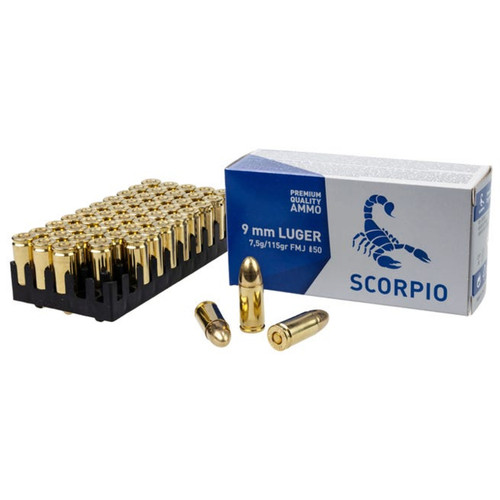If you’re taking your first steps into the world of the AR-15, chances are you’ve noticed something: there are a lot of different sizes going on.
From barrel length to cartridge caliber to twist rate, the AR-15 is one of the most customizable small arms platforms out there. However, all of that flexibility means that an operator needs to know a plethora of different dimensions in order to know what’s best to use.
While all the variables surrounding the AR-15 can be a little intimidating to newcomers, the AR-15 actually becomes pretty intuitive once you understand it. Use this size guide from Pro Armory to help you choose all the right ammo, parts, cases, and accessories you need for your AR-15.
Getting Started: AR-15 Barrel Lengths and Twist Rates
First off, let’s look at why there are different sizes of AR-15s in the first place. When it comes to America’s most popular sporting rifle, the size of your gun will come down to a few factors. Two of the biggest factors are barrel length and twist rate. To determine which of these variables will best serve your purposes (and thus determine the length of case you need), you need to understand how they work.
AR-15 Barrel Lengths
The main variable affecting your AR-15’s overall size is its barrel length. Some of the most common barrel lengths for an AR include 18 inches (the original length of the military’s M-16), 16 inches (probably the most popular today), and short-barreled lengths like 14.5 inches and 10.3 inches. Ultimately, the “best” AR-15 barrel length for you will depend on what you want from your ideal firearm.
Long Barrels
A longer barrel will increase your muzzle velocity, since it allows for more expanding gas to push the bullet forward and out of the firearm. Longer barrels also give you a longer line of sight, allowing a practiced shooter to execute more accurate shots. Finally, longer barrels extend the firearm’s overall effective range.
However, that doesn’t mean that a longer barrel is without drawbacks. For one thing, a long barrel makes your firearm more front-heavy, making it harder to fire while standing (or “offhand”). It also means the gun will be less maneuverable. As a result, ARs with long barrels aren’t ideal for use indoors or from a car.
Short Barrels
On the other hand, shorter barrels make for a more nimble firearm. That makes them better for moving around corners and clearing rooms if you’re inside a building. A shorter barrel also makes a firearm potentially more concealable.
Also, bear in mind that laws can impact your AR-15’s ideal barrel length. If you have an AR-15 with a barrel length shorter than 16 inches, you’ll need to register it as a short-barreled rifle (SBR) with the ATF. You may also have state-level rules that affect what barrel lengths you can legally use, too.
AR-15 Twist Rates
When you shoot an AR-15, the bullet doesn’t just travel straight to the target. There are grooves in the barrel that cause the bullet to spin, or twist. This helps stabilize the bullet as it travels through the air. It’s the same idea as throwing a football with a nice, tight spiral.
Longer barrels tend to have slower twist rates, while shorter barrels typically require faster twist rates. With a longer barrel, the bullet has more time to stabilize before it exits the barrel. In contrast, shorter barrels require a faster twist rate to stabilize the bullet within a shorter distance.
It’s important to note that twist rates don’t exactly determine how long your barrel will be, and there is no one-size-fits-all choice in this case. The optimal twist rate often depends on the exact caliber of your AR-15, how you use your gun, etc. With that in mind, certain twist rates tend to play nicer with certain barrel lengths and bullet weights. So, it’s an important factor to consider when looking at the overall length of your AR.
When it comes to civilian AR-15s in the US, three twist rates are the most common. Generally, you’ll see twist rates of 1:7, 1:8, and 1:9. A smaller number means that the barrel twists more times in a shorter distance. A 1:7 twist rate is probably the most common, and it’s the same rate that the military uses on its M16 rifles and M4 carbines. As a rule of thumb, a smaller twist rate on an AR-15 is best for lighter bullets.
| Twist Rate | Best Bullet Weight |
|---|---|
| 1:7 | 40-62 grains |
| 1:8 | 62-77 grains |
| 1:9 | 69-87 grains |
Keep in mind that you can safely fire any grain of .223/5.56 ammo from your AR-15 (provided that’s what the gun is chambered in). You’ll just get suboptimal performance if you use a twist rate that it wasn’t designed for.
What Size Case Should I Get For My AR-15?
Okay, so we’ve covered what factors exactly will determine the size of your AR-15. Now, let’s explore which sizes of case you should be looking at.
Some of the best sized cases for an AR-15 in America today are 36 inches or 42 inches long by 10 inches wide. These cases generally give you enough room to store a rifle with nearly any barrel length, and the 10-inch width will allow you to fit any optic attached to the rifle and store extra gear like magazines. However, some hard cases may be slightly longer than average.
Hard vs. Soft Cases for an AR-15
There’s more to consider with rifle cases than size alone. You’ll also need to decide whether to use a soft or hard case.
- Hard Cases: Hard cases utilize materials like injection-molded plastics in their construction. Depending on their quality, many hard-shelled cases can hold hundreds of pounds of pressure.
- Soft Cases: Soft cases usually involve some kind of high-quality nylon that are double-stitched for extra toughness. Cordura is an example of a commonly used material in soft rifle cases.
A lot of this decision will come down to a price vs. durability debate. Hard cases are generally more durable, and they’re also secure enough to allow you to lock your hardware inside. If you’re using a soft case, attachments like pockets, Velcro, or MOLLE loops may allow you to store extra gear.
You’ll want to choose your case based on how you’re going to use it. Need something secure for long term storage? Consider a hard case. Just looking for something to lug your AR to the range? A soft case may be your best bet.
Hard Case Recommendations
If you’re looking for a hard case for your AR-15, Plano and SKB both offer great products to protect your gun from the elements and store any attachments easily.
- Plano Element Double Long Gun Case, 54”: (Dimensions: 54"L x 15"W x 6.4"H)If your AR-15 is your baby, it can’t be much safer than it is with this Plano case. With industrial-strength construction, stainless steel reinforced padlock gates, and continuous Dri-Loc seal, this case is both waterproof and dust-proof. That means it can withstand some of the worst weather conditions. Plus, the double-density, customizable foam interior provides extra protection during transport. You can also take this thing on a plane. The built-in pressure equalizer valve makes it TSA-approved for airline travel, and it even has wheels for smoother transport.
- SKB iSeries M4 Short Case, 36”: (Dimensions: 36.5” L x 14.5” W x 6” H) SKB is already known around the world for their molded polymer cases. This iSeries case M4 Injection Molded, Military-Standard Case is just one more reason to love the brand. Waterproof, dust-tight, and completely submersible, this case is built to withstand the elements. With an ultra high-strength polypropylene copolymer resin construction, the case has a MIL-STD 810G rating — that means it’s corrosion and impact damage resistant. What’s more, the patented trigger release latches can be retrofitted with TSA accepted key locking latches, padlock loops, and stainless steel padlock protector clips, if you choose, offering fantastic security for travel.
Soft Case Recommendations
If you’re looking for a soft case, these are the best we can recommend. While they won’t be as protective as a hard case, they will certainly keep it safer than storing it like a skateboard in your closet. These also include other valuable features for AR-15 owners looking to accessorize.
- The Bulldog Deluxe Double Rifle Case, 36”: (Dimensions: 37” L x 15” W x 9” H) This soft case is big enough to comfortably store two AR-15s with 16” barrels. It even includes a padded internal divider in the quilted rifle compartment for this very purpose. With large padded back straps, you can carry this soft case on your back anywhere you go and trust that the lockable zipper and adjustable tie downs will keep your AR secure during transport. It also features multiple magazine compartments and three large accessory pockets lined with high-visibility cloth.
- Allen Tac Six Squad Case, 42”: (Dimensions: 43” L x 13” W x 4.5” H) With an all-weather 600D polyester exterior and interior, this case is incredibly durable. The design features two compartments to comfortably store two 16-inch barrelled ARs. The laser cut MOLLE system on the front pocket allows you to store and organize your most valuable accessories. Likewise, the large front compartment features four magazine loops for your convenience. Rope handles make this case easy and comfortable to transport as well.
Caliber Countdown: What Size Ammo Does an AR-15 Use?
We’ve arrived at what’s probably one of the most open-ended questions in the world of firearms: what size of ammo does an AR-15 use? Buckle up and get ready for a trip down the rabbit hole on this one.
The AR-15 is one of the most versatile small arms weapon platforms in history. It’s pretty remarkable when you consider that a design more than six decades old is still in common use today. By mixing and matching different parts of the firearm, notably magazines and upper receivers, you can shoot a huge variety of ammo from the same gun.
5.56 vs 223: What’s the Difference?
When it comes to the AR-15, two different types of ammo reign supreme: the 223 Remington and the 5.56 NATO. Both of these cartridges are essentially the same. They’re intermediate-range rounds that can stop anything from a varmint to a deer (or someone breaking into your home). In fact, the 5.56 is based on the .223 design.
The only real difference between .223 and 5.56 is that the latter has a higher chamber pressure. This means that guns designed for 5.56 can fire .223, but not vice versa. To be on the safe side, you probably want to keep a stamp on your gun that says either “5.56” or “.223” and keep your magazines loaded exclusively with one round — never mix them. You don’t want to risk blowing up the gun in your hands.
That said, the majority of modern AR-15 platforms are chambered in 5.56. They can safely fire both cartridges.
Other Types of AR-15 Ammo
Although .223 and 5.56 may be the most common cartridges for the AR-15, they’re far from the only thing you can feed this platform. By swapping out different upper receivers, you can also safely fire other cartridges from your AR-15. Some of the biggest nonstandard rounds include the 50 Beowulf, 458 SOCOM, and the 300 Blackout.
300 Blackout is probably the most popular of these nonstandard cartridges. The 300 Blackout’s fat, heavy bullet makes it a great choice for shorter barreled rifles — they even make subsonic ammo for use with suppressors.
Just be careful if you use the same gun for both .223/5.56 and 300 Blackout. If you accidentally shoot a 300 Blackout round from a .223/5.56 upper receiver, you’re going to have a bad time.
Seriously, your gun will blow up. Don’t do it.
Brass vs. Steel Case Ammo for AR-15s
Should you use steel or brass cased ammunition? As usual, it depends. You’ll want to pick ammo that helps you achieve your shooting goals.
When it comes to performance, brass cased ammo is king. Brass casings create a better pressure seal, trapping more gasses when you fire a bullet and transferring that into downrange energy. You can also reload brass cased ammo easily, saving yourself a ton of money. Competition shooters and budget-conscious gun enthusiasts alike can benefit from reloading their own rounds (with the proper tools and precautions, of course).
Steel cased ammo is more of a wild card. You can’t reload it the same way you would brass cased ammo, and it has a reputation for being less accurate. However, if you’re a prepper type waiting for a “SHTF” scenario, steel cased ammo is your friend. Bullet factories cover steel cased ammo with a special polymer coating that seals out moisture, making it great for long term storage. It’s damn cheap, too.
Lead-Free Ammo
Aside from the material of your casing, you should also consider the construction of the actual bullets you’re using. One big innovation in ammunition over the last few years is the introduction of lead-free ammo. It’s no secret that lead isn’t good for the environment or the human body. That’s why lead-free ammo is beginning to become more popular, especially among hunters who want cleaner meat on their dinner tables.
Big Boys: High-Powered Ammo for the AR-15 Platform
Looking for something that can travel farther and hit harder than the standard intermediate cartridges for your AR-15? While it’s not technically an AR-15, the AR-10 platform essentially functions the same way with bigger bullets. The AR-10 platform is best known for being the “AR-15 on steroids.” It specializes in large battle rifle cartridges like the ubiquitous .308 Winchester and the U.S. SOCOM’s official favorite: the 6.5 Creedmoor.
Capacity: How Many Rounds Does an AR-15 Hold?
Finally, we’ll take a look at exactly how many rounds an AR-15 can hold. Ultimately, two different factors will determine your gun’s capacity. On one hand, you have the physics of size — bigger cartridges take up more space, obviously. On the other, you have a complex network of local, state, and federal laws that will also affect how many rounds an AR-15 can hold.
As we mentioned earlier, the AR-15 isn’t limited to a single caliber. Instead, it can use a variety of different cartridges depending on how your firearm is chambered. This is where the physical size of your ammo comes into play. For example, 50 Beowulf cartridges are designed to use the same magazines as a standard .223 magazine. However, since 50 Beowulf is a much larger cartridge, you can only fit 10 of these rounds into a 30-round .223 magazine.
AR-15 Magazine Capacity Laws
While the previous situation is definitely one that you can run into, the most common limiting factor on your AR-15 magazine’s capacity will be gun laws. In many states (think New York, California, and Massachusetts), local laws cap the number of rounds you can legally keep in a magazine. That’s one of the main reasons you have a market for things like 10-round AR-15 mags.
Some of these magazines may physically be smaller and only capable of fitting a certain number of rounds due to their size. Others have more subtle compliance features. For example, some AR-15 magazines look like standard size 30-rounders, but they incorporate a kind of internal system that prevents an operator from loading more than the legal amount of cartridges.
The Wrap-Up: Getting Started with the AR-15
If you’re feeling a little overwhelmed by all this information, don’t worry. It’s a lot for anyone to comprehend all at once. Here’s the biggest takeaway when it comes to determining sizes for your AR-15 and related gear:
Regardless of which variable you’re looking at — be it the barrel length, twist rate, caliber, or capacity of your AR-15, there’s no such thing as the “best.” Instead, you’ll need to decide what you want your rifle to actually do for you. From there, you can choose which options help you achieve that goal.
Ready to set off on your journey into the vast world of the AR-15? Check out the ammo we have in stock today — and if you’re a dealer, don’t sleep on our bulk pricing!


























